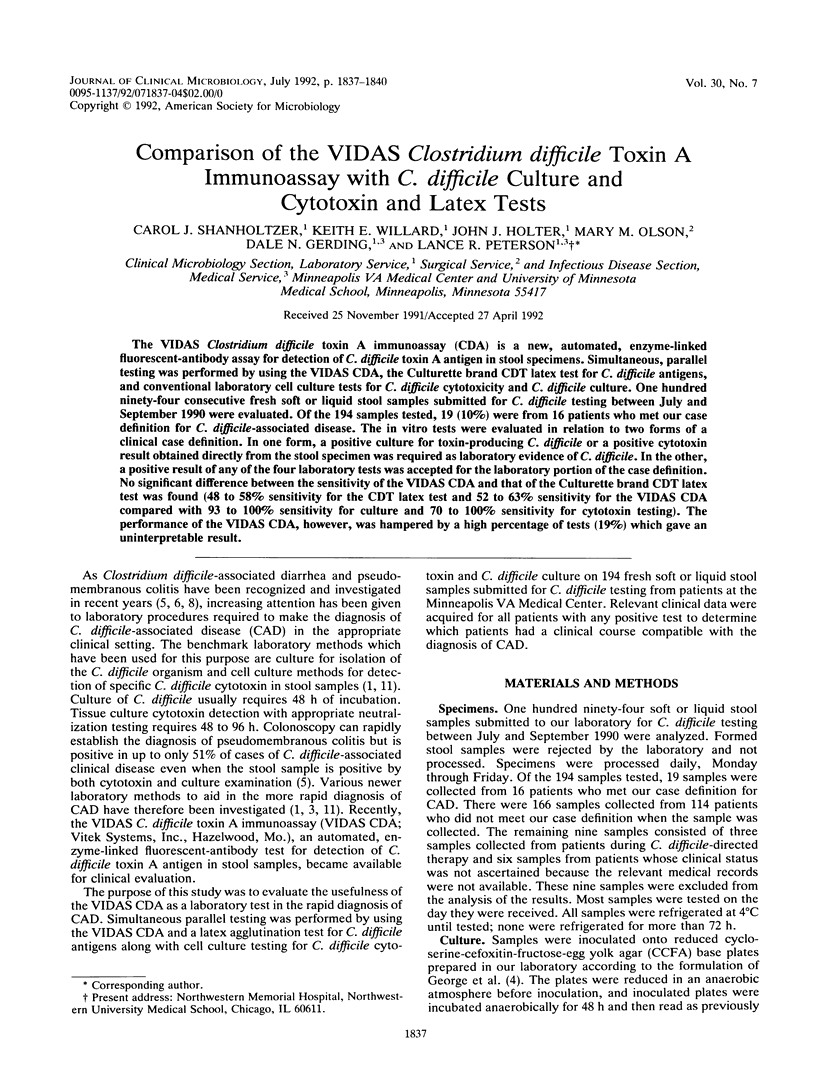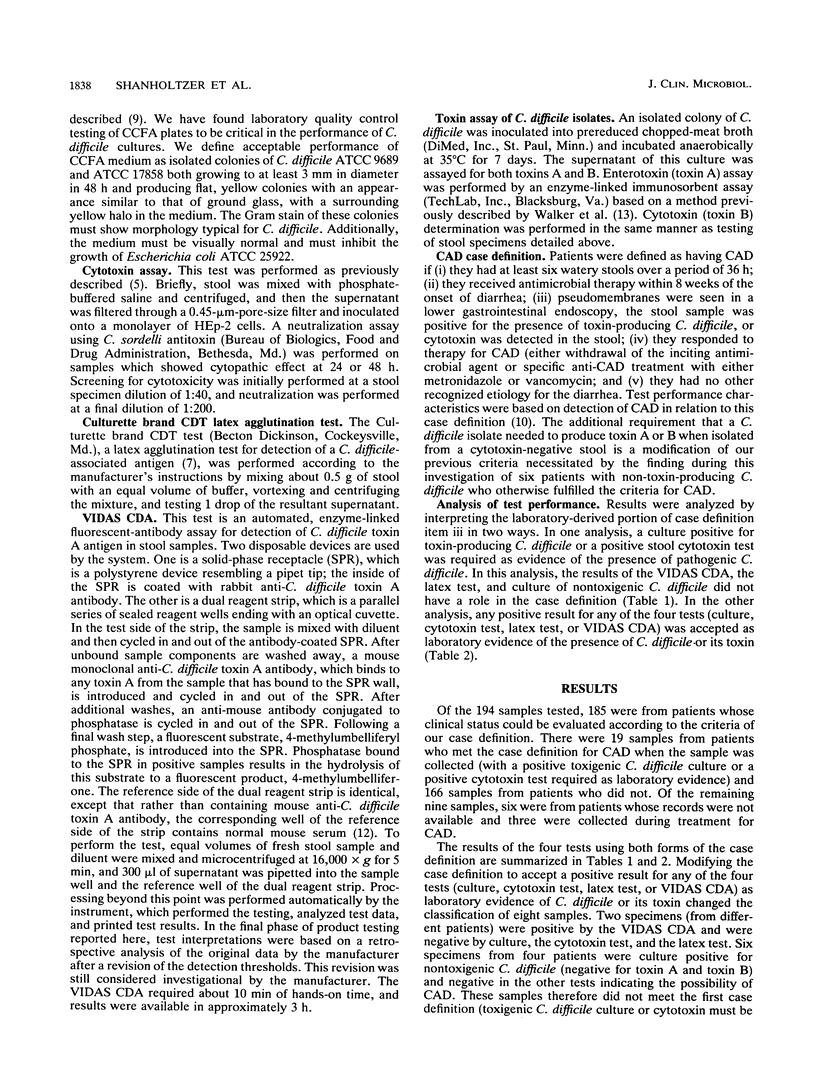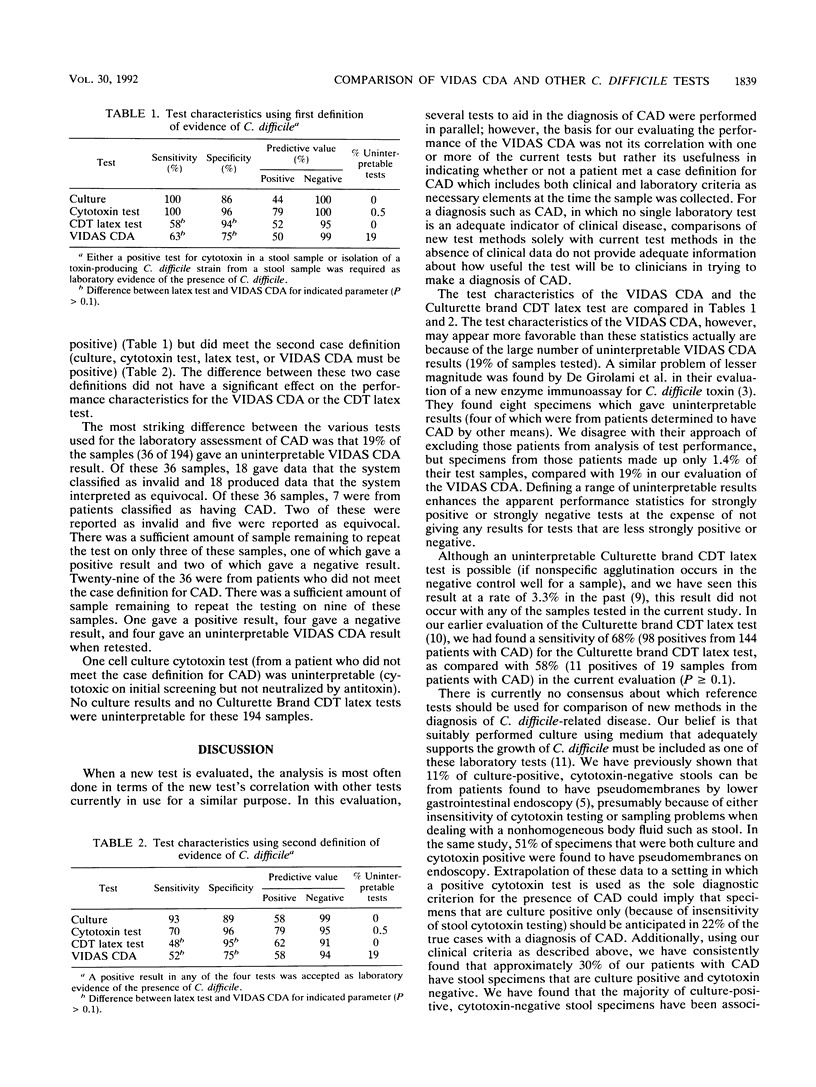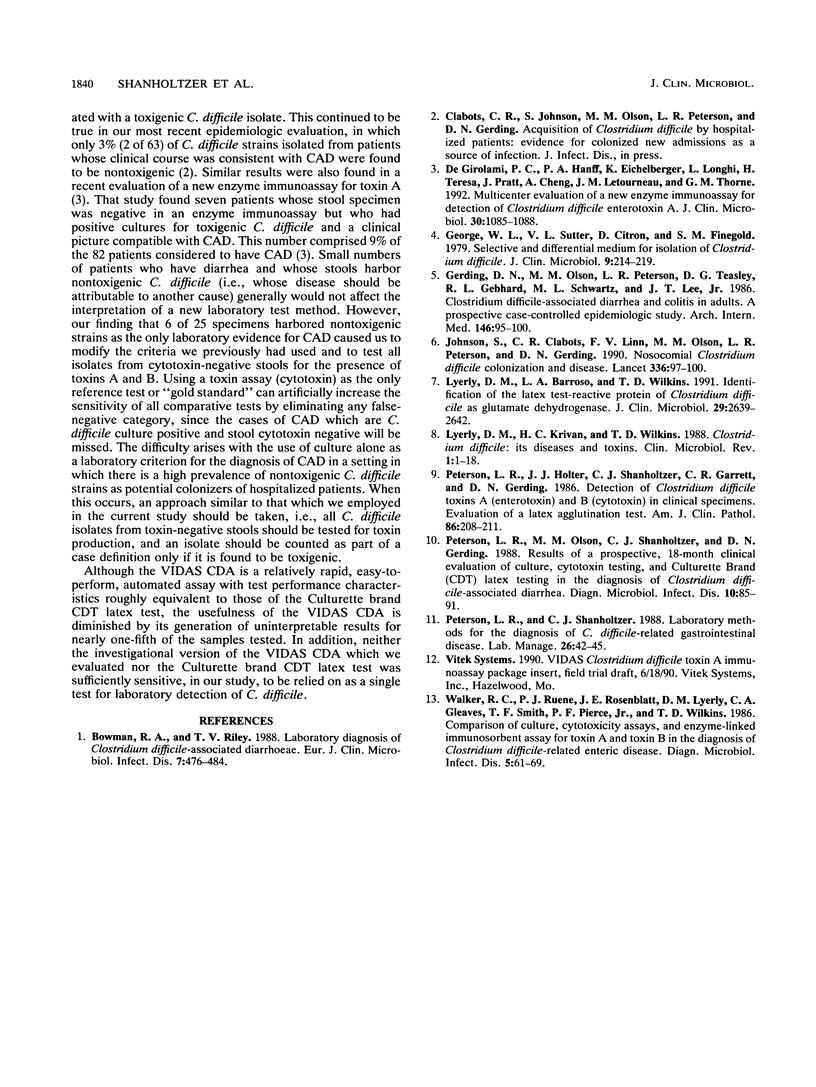Abstract
The VIDAS Clostridium difficile toxin A immunoassay (CDA) is a new, automated, enzyme-linked fluorescent-antibody assay for detection of C. difficile toxin A antigen in stool specimens. Simultaneous, parallel testing was performed by using the VIDAS CDA, the Culturette brand CDT latex test for C. difficile antigens, and conventional laboratory cell culture tests for C. difficile, cytotoxicity and C. difficile culture. One hundred ninety-four consecutive fresh soft or liquid stool samples submitted for C. difficile testing between July and September 1990 were evaluated. Of the 194 samples tested, 19 (10%) were from 16 patients who met our case definition for C. difficile-associated disease. The in vitro tests were evaluated in relation to two forms of a clinical case definition. In one form, a positive culture for toxin-producing C. difficile or a positive cytotoxin result obtained directly from the stool specimen was required as laboratory evidence of C. difficile. In the other, a positive result of any of the four laboratory tests was accepted for the laboratory portion of the case definition. No significant difference between the sensitivity of the VIDAS CDA and that of the Culturette brand CDT latex test was found (48 to 58% sensitivity for the CDT latex test and 52 to 63% sensitivity for the VIDAS CDA compared with 93 to 100% sensitivity for culture and 70 to 100% sensitivity for cytotoxin testing). The performance of the VIDAS CDA, however, was hampered by a high percentage of tests (19%) which gave an uninterpretable result.
Full text
PDF



Selected References
These references are in PubMed. This may not be the complete list of references from this article.
- Bowman R. A., Riley T. V. Laboratory diagnosis of Clostridium difficile-associated diarrhoea. Eur J Clin Microbiol Infect Dis. 1988 Aug;7(4):476–484. doi: 10.1007/BF01962596. [DOI] [PubMed] [Google Scholar]
- De Girolami P. C., Hanff P. A., Eichelberger K., Longhi L., Teresa H., Pratt J., Cheng A., Letourneau J. M., Thorne G. M. Multicenter evaluation of a new enzyme immunoassay for detection of Clostridium difficile enterotoxin A. J Clin Microbiol. 1992 May;30(5):1085–1088. doi: 10.1128/jcm.30.5.1085-1088.1992. [DOI] [PMC free article] [PubMed] [Google Scholar]
- George W. L., Sutter V. L., Citron D., Finegold S. M. Selective and differential medium for isolation of Clostridium difficile. J Clin Microbiol. 1979 Feb;9(2):214–219. doi: 10.1128/jcm.9.2.214-219.1979. [DOI] [PMC free article] [PubMed] [Google Scholar]
- Gerding D. N., Olson M. M., Peterson L. R., Teasley D. G., Gebhard R. L., Schwartz M. L., Lee J. T., Jr Clostridium difficile-associated diarrhea and colitis in adults. A prospective case-controlled epidemiologic study. Arch Intern Med. 1986 Jan;146(1):95–100. [PubMed] [Google Scholar]
- Johnson S., Clabots C. R., Linn F. V., Olson M. M., Peterson L. R., Gerding D. N. Nosocomial Clostridium difficile colonisation and disease. Lancet. 1990 Jul 14;336(8707):97–100. doi: 10.1016/0140-6736(90)91605-a. [DOI] [PubMed] [Google Scholar]
- Lyerly D. M., Barroso L. A., Wilkins T. D. Identification of the latex test-reactive protein of Clostridium difficile as glutamate dehydrogenase. J Clin Microbiol. 1991 Nov;29(11):2639–2642. doi: 10.1128/jcm.29.11.2639-2642.1991. [DOI] [PMC free article] [PubMed] [Google Scholar]
- Lyerly D. M., Krivan H. C., Wilkins T. D. Clostridium difficile: its disease and toxins. Clin Microbiol Rev. 1988 Jan;1(1):1–18. doi: 10.1128/cmr.1.1.1. [DOI] [PMC free article] [PubMed] [Google Scholar]
- Peterson L. R., Holter J. J., Shanholtzer C. J., Garrett C. R., Gerding D. N. Detection of Clostridium difficile toxins A (enterotoxin) and B (cytotoxin) in clinical specimens. Evaluation of a latex agglutination test. Am J Clin Pathol. 1986 Aug;86(2):208–211. doi: 10.1093/ajcp/86.2.208. [DOI] [PubMed] [Google Scholar]
- Peterson L. R., Olson M. M., Shanholtzer C. J., Gerding D. N. Results of a prospective, 18-month clinical evaluation of culture, cytotoxin testing, and culturette brand (CDT) latex testing in the diagnosis of Clostridium difficile-associated diarrhea. Diagn Microbiol Infect Dis. 1988 Jun;10(2):85–91. doi: 10.1016/0732-8893(88)90045-4. [DOI] [PubMed] [Google Scholar]
- Walker R. C., Ruane P. J., Rosenblatt J. E., Lyerly D. M., Gleaves C. A., Smith T. F., Pierce P. F., Jr, Wilkins T. D. Comparison of culture, cytotoxicity assays, and enzyme-linked immunosorbent assay for toxin A and toxin B in the diagnosis of Clostridium difficile-related enteric disease. Diagn Microbiol Infect Dis. 1986 May;5(1):61–69. doi: 10.1016/0732-8893(86)90092-1. [DOI] [PubMed] [Google Scholar]


